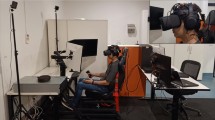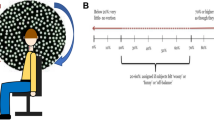Abstract
• Background: We have previously reported that neck muscle vibration can induce visual illusory movements and eye movements under subdued ambient illumination in human subjects with the head and body fixed. The subjects viewed a fixation light with one eye and the other eye was covered. The eye movements were recorded with an infrared system mounted in goggles attached to the head of the subject. • Methods: In order to further examine the properties of these cervico-ocular reactions and reveal any artefacts in the eye movement recordings, we have studied (1) the effect of increasing the ambient light, which made visual illusory movements disappear, (2) the timing between the illusory movement and the eye movement in subdued light, (3) the effect of viewing the target through a pin-hole, which would reveal artefacts due to head movement, and (4) the effect of mounting the eye movement recording system on the head support, which would allow recording to the absolute eye position change. • Results: The results of these experiments showed no significant difference from those that were reported previously. Eye movements of about the same amplitude were induced in both eyes under all conditions, and there was no time difference in the occurrence of visual illusory movements and eye movements. • Conclusion: The results of this study confirm that neck muscle vibration can induce eye position changes. This seems to confirm that the proprioceptive messages originating in the neck muscles are processed together with visual information of eye position in determining gaze direction.
Similar content being viewed by others
References
Abrahams VC, Richmond F, Rose PK (1974) Basic physiology of the head-eye movement system. In: Lennerstrand G, Bach-y-Rica P (eds) Basic mechanisms of ocular motility and their clinical implications. Pergamon Press, Oxford, pp 473–476
Barany R (1908) Augenbewegungen durch Thoraxbewegungen ausgelöst. Zentralbl Physiol 20:298–302
Barlow D, Freedman W (1980) Cervico-ocular reflex in the normal adult. Acta Otolaryngol 89:487–496
Biguer B, Donaldson IML, Hein A, Jeannerod M (1988) Neck muscle vibration modifies the representation of visual motion and direction in man. Brain 111:1405–1424
Campos EC, Bolzani R, Schiavi C, Fanti MR, Cavallini GM (1989) Further evidence for the role of proprioception in space perception. Doe Ophthalmol 72:155–160
Doerr M, Leopold HC, Thoden U (1981) Vestibulo-ocular reflex (VOR), cervico-ocular reflex (COR) and its interaction in active head movements. Arch Psychiatr Nervenkrankh 230:117–127
Fitts PM, Peterson JR (1964) Information capacity of discrete motor responses. J Exp Psychol 67:103–112
Han Y, Lennerstrand G (1995) Eye movements in normal subjects induced by vibratory activation of neck muscle proprioceptors. Acta Ophthalmol Scand 73:414–416
Hildingsson C, Wenngren BI, Toolanen G (1993) Eye motility dysfunction after soft-tissue injury of the the cervical spine. Acta Orthop Scand 64:129–132
Jürgens R, Mergner T (1989) Interaction between cervico-ocular and vestibulo-ocular reflexes in normal adults. Exp Brain Res 77:381–390
Lackner JR, Levine MS (1979) Changes in apparent body orientation and sensory localization induced by vibration of postural muscles: vibratory myesthetic illusions. Aviat Space Environ Med 50:346–354
Lennerstrand G (1988) Peripheral mechanisms of ocular motor proprioceptive control. In: Tamura O, Tsutsui J (eds) International workshop on proprioception of ocular muscles. Ehime University Press, Ehime, Japan, pp 219–225
Lund S (1980) Postural effects of neck muscle vibration in man. Experientia 36:1398
Matthews PBC (1982) Where does Sherrington's “muscular sense” originate? Muscles, joints, corollary discharges? Annu Rev Neurosci 5:189–218
Roll JP, Vedel JP (1982) Kinaesthetic role of muscle afferents in man, studied by tendon vibration and microneurography. Exp Brain Res 47:177–190
Roll JP, Roll R (1988) From eye to foot: a proprioceptive chain involved in postural control. In: Amblard B, Berthoz A, Clarac F (eds) Posture and gait: development, adaptation and modulation. Excerpta Medica, Amsterdam, pp 155–164
Roll JP, Vedel JP, Roll R (1989) Eye, head and skeletal muscle spindle feedback in the elaboration of body references. Prog Brain Res 80:113–123
Roll R, Velay JL, Roll JP (1991) Eye and neck proprioceptive messages contribute to the spatial coding of retinal input in visually oriented activities. Exp Brain Res 85:423–431
Steinbach M, Musarella MA, Gallie BL (1987) Extraocular muscle proprioception and visual function: psychophysical aspects. In: Lennerstrand G, von Noorden GK, Campos E (eds) Strabismus and amblyopia. Macmillan, London, pp 327–335
Takemori S, Suzuki JI (1971) Eye deviations from neck torsion in humans. Ann Otol 80:439–444
Tynan PD, Sekuler R (1982) Motion processing in peripheral vision: reaction time and perceived velocity. Vision Res 22:61–68
Velay JL, Roll R, Lennerstrand G, Roll JP (1994) Eye proprioception and visual localization in human: influence of ocular dominance and visual context. Vision Res 34:2169–2176
Author information
Authors and Affiliations
Rights and permissions
About this article
Cite this article
Lennerstrand, G., Han, Y. & Velay, JL. Properties of eye movements induced by activation of neck muscle proprioceptors. Graefe's Arch Clin Exp Ophthalmol 234, 703–709 (1996). https://doi.org/10.1007/BF00292357
Received:
Revised:
Accepted:
Issue Date:
DOI: https://doi.org/10.1007/BF00292357




